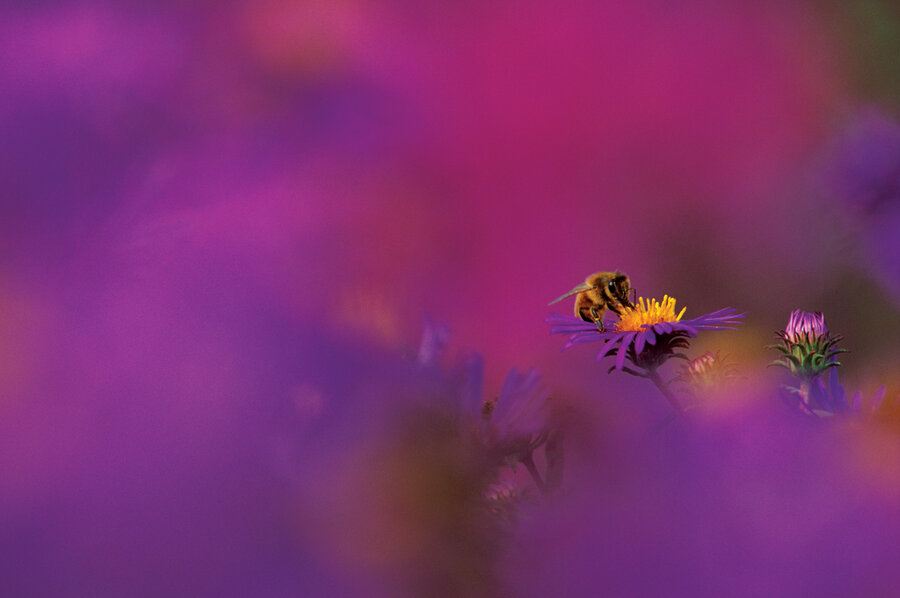Peering into the honeybee's world of elegant order
Loading...
I am standing with a friend in a wide clearing atop a North Carolina mountain, the afternoon sun threading like golden lace through the trees. Before us are two white wooden boxes, and all around is the dense humming of her honeybees, the very air in motion.
We are dressed as if for a NASA shuttle launch, but as the bees swarm around us intruders, I'm grateful for the protection. Even with the cumbersome headgear and heavy gloves, it takes several moments for me to move beyond my fear of stinging insects. But my trepidation is quickly pushed aside by a growing sense of wonder.
I kneel next to the box that is the focus of our attention and listen to what sounds like an attic fan coming from deep within the hive, thousands of busy wings fanning together to cool the interior. Even in the dead of winter, my friend tells me, the honeybees can keep the hive as warm as 80 to 90 degrees F. I find there is something comforting about the humming, sustained vibrations that bring me an odd sense of peace.
On this summer day, the air is redolent with the scent of beeswax, honey, and something else that is faintly reminiscent of warm toast, propolis, the sticky tree resin bees use to seal cracks in the hive. I lean over the top of the smaller of the two hives, handing my friend one of the tools she will use to take it apart. My friend pries up the super, the box on top containing frames heavy with honeycomb, and the humming turns to a frantic buzz. I work to keep my composure as dozens of displaced bees crawl up my canvas-covered arms and across the plastic face of my bee bonnet, and it seems as I calm down, so do the bees.
It is important to move with care around bees, so by nature it's relaxing work. We take apart each section, making our way to the bottom, the brood box. One by one, we remove the frames, checking for honey production, pollen, water supply, and brood activity, gauging the general health of the bees. The occasional drone wanders across a frame as if he's working his way through traffic while busy workers scramble over and around him. The male drones are larger than their female counterparts, the worker bees; the males cannot sting, and their only role is to breed with the queen.
The females do all the work to keep the hive going. They can and will sting when threatened, but this sole mode of self-defense is also one of sacrifice, as the act of stinging ruptures the abdomen and kills the bee. House bees, still too young to fly outside the hive, tend to the work inside, while the older field bees shuttle between hive and surrounding meadows, gathering pollen, nectar, water, and propolis.
As my friend inspects each section, she speaks to the frantic workers in a soothing tone. "It's OK, girls, I'd be mad, too, if somebody came in and started moving the walls around in my house." I wonder about talking to bees, but who knows what pacifying effect the low vibrations of her voice might have?
She draws out one last frame and with a gloved finger points to a few gleaming larvae. "Those are the babies," she whispers as quietly as if we are peeking our heads around the half-open door of a nursery. Several nursemaid bees hover protectively.
Honeybees are remarkably sociable creatures. They groom one another, cleaning one another's antennae and legs, and when one is injured or killed, members of the hive will gather in a cluster of concern. They are also surprisingly delicate, so vulnerable to temperature changes that even a summer rainstorm can prove fatal if a bee is caught without shelter.
My friend's bees seem healthy today. With the inspection complete she pours syrupy sugar water into a feeder box to supplement their food supply, and we replace each frame.
With the hive reassembled, the bees move back and forth, restoring order as the slanting sun bathes us all in its glow, and I find myself thinking of ancient stories in which bright angels unfurled wings of burnished gold. I feel a deep sense of privilege, as if I've witnessed a miraculous event, and my eyes smart with unshed tears.
Around and above me a wave of bees swirls in a slow-motion ronde, and the humming in the clearing seems to grow deeper.
Or maybe it's just me, tuning in to a brand-new frequency.





